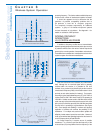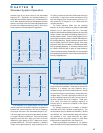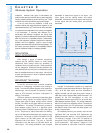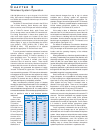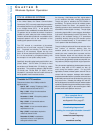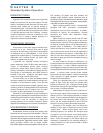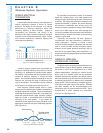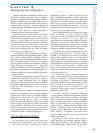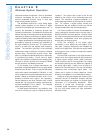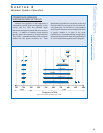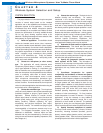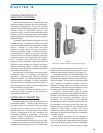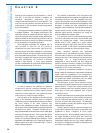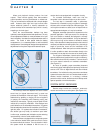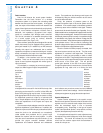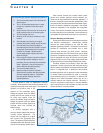
width than wireless microphones. Even so, bandwidth
limitations necessitate the use of companders to
achieve acceptable dynamic range in most high
quality analog wireless systems.
The bandwidth required for a high fidelity digital
wireless system depends on the amount of digital
information transmitted and the transmission rate. In
practice, the bandwidth is limited by physical and
regulatory requirements. This effectively constrains the
amount and rate of information that can be transmitted.
Ultimately, the fidelity and reliability of a digital wireless
system is limited by these same bandwidth restrictions.
A digital representation of an analog audio signal is
generated by sampling (measuring the amplitude of)
the audio waveform at some rate. The rate must be
equal to at least twice the highest audio frequency
desired. The resolution (accuracy) of the amplitude
measurement must be sufficient to handle the desired
dynamic range. The resolution is given in "bits". 8-bit
audio is considered moderate fidelity while 16-bit audio
is considered high fidelity. The bit rate of a digital
signal is the resolution multiplied by the sampling rate.
CD audio is 16 bits x 44.1KHz for a bit rate of 705,600
bits per second or 705.6Kbits-per-second.
In the simplest form of digital transmission, the
theoretical occupied bandwidth of such a signal would
be equal to the bit rate. That is, to transmit CD-quality
audio would require a bandwidth of 705.6KHz. In "real
world" systems the occupied bandwidth would be even
greater. Based on allowable deviation limits it is not
possible to transmit such a signal. By comparison,
cellular telephones use 8-bit resolution with a 6KHz
sample rate. By using special "coding" techniques the
occupied bandwidth is only 30KHz. The resulting
audio quality difference is obvious.
In digital signal transmission it is possible to send
more than one bit per cycle by coding the bits into
"symbols". The symbol rate is equal to the bit rate
divided by the number of bits transmitted with each
symbol. The theoretical occupied bandwidth of a
coded digital transmission is then equal to the "symbol"
rate. For instance, a digital coding scheme that
transmits two bits per symbol will have only half the
occupied bandwidth of the CD example above.
It is further possible to reduce the bandwidth by
using compression schemes similar to those used in
MiniDisc and MP3 recording devices. However, these
are "lossy" techniques that eliminate some of the audio
information. Nevertheless, when done properly, the
audio quality can be quite good.
Finally, the "reliability" of the digital signal
transmission is also affected by the integrity of the
radio path. Dropouts, interference, and multipath can
cause loss of digital data. Extra bits are usually added
to the signal for error correction, though this increases
bandwidth slightly.
One issue that is important in any digital scheme is
latency, which is the signal delay that occurs whenever
a signal passes through certain digital processes.
These include the A/D or D/A converters, the coding
and decoding devices and any DSP that is applied in
the analog signal path. Latency must be kept to a
minimum to avoid distraction to the user and possible
interference with non-delayed signal paths. The
latency that is typical of cellular telephone circuits
would be unacceptable in a live performance setting.
Traditional analog transmitters and receivers use a
moderate amount of bandwidth. Complex transmit/
receive technologies are required to transmit digital
information in a comparable bandwidth. Since
spectrum is limited and increasingly crowded,
successful digital transmission systems must have
not only high audio quality but high bandwidth-
efficiency as well.
Selection
and Operation
of Wireless Microphone Systems
34
C HAPTER 3
Wireless System Operation



